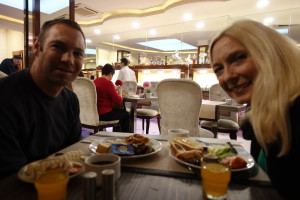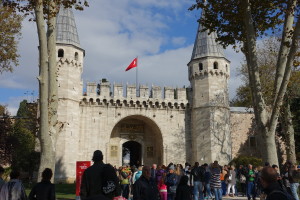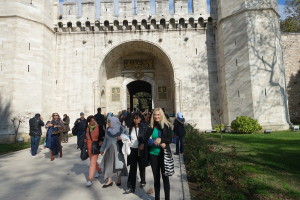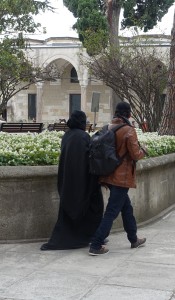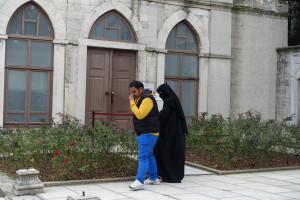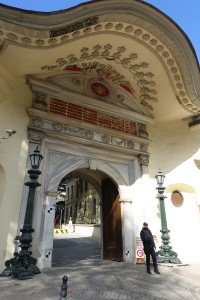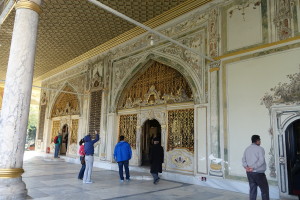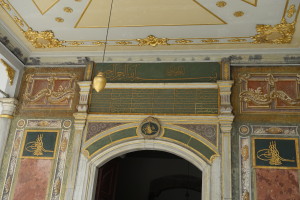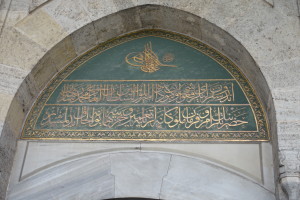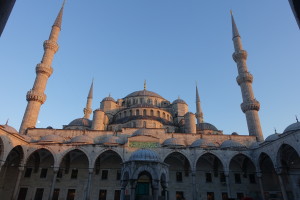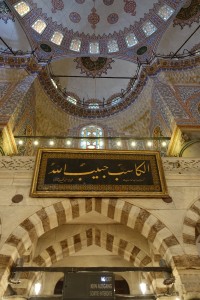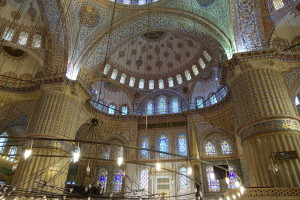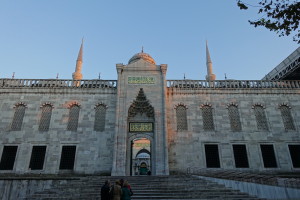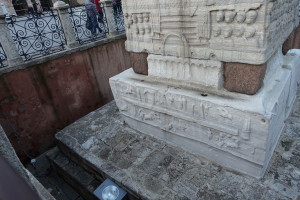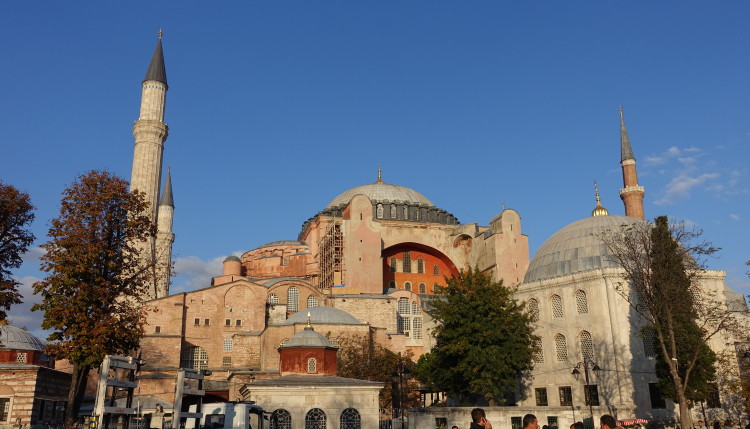
First Full Day in Istanbul
The start of our day in Sultanahmet began with a good meal and Turkish coffee. Fortunately our Hotel provided a great start to the day. Whether an American breakfast or a more continental styled one, there was much to taste and discover here!
Stepping outside the hotel onto the street, a change occurs. The muezzin’s call to worship to believers five times a day (via loud speakers) scattered all over the city could never be ignored (and apparently weren’t meant to be).
Beginning at daybreak the chant/call to prayer begins by reminding listeners, “Prayer is better than sleep.” The muezzin continues by shouting four times, “Allah is Most Great; then, “I bear witness that there is no god but Allah”( twice). He calls out, “I bear witness that Muhammad is the messenger of Allah” (twice); followed by, “come to prayer” (twice); “come to the good” (twice) and finally closing with “Allah is most great” (two more times).
Does anyone really listen? Can anyone actually ignore these?
Whether it was due to the broad mixture of cultures or a more westernized islamic faith, we didn’t witness any public responses to these calls for prayer. It was hard enough listening to these “chants” without actually witnessing men kneeling on rugs with heads bowed to Allah.
Nevertheless, this extreme Islamic behavior (and thinking) invades this modern city. This is not a watered down Islamic religion practiced in our more westernized countries. These core values and practices displayed here date back to the Ottoman period. Both the core beliefs and expected behaviors dictate every facet of life–relationships and family life; governing laws and religious rules; school and social interactions–everything falls under accepted and dictated practices of Islam for men, women and children.
Clothing stores on the main tourist streets contained silks, leathers and furs. Those on side streets held appropriate dress styles for modest muslim women—cotton undergarments, long dark skirts and black burkas. Except for one expensive leather and fur shop every store we entered ignored our presence and never said a word to us as we looked around. Shops appealing to tourists still catered to muslim populations.
Topkapi Palace–residence of the Ottoman Sultans for over 400 years–is centrally located within Sultanahmet. In 1924, following the formal abolishment of the caliphate, this palace was converted into a museum, thus allowing general public access to some of the areas.
We stood out, or rather, I stood out. My blonde hair and westernized clothing separated me from the muslim women cloaked in black garments. Though I thought I dressed modestly and often covered my head with a black scarf. I was still uncovered compared to the muslim women and stood out
Muslim men dressed in modern clothing (jeans, tennis shoes and comfortable shirts) with backpacks and leather coats while their women were covered head to toe following behind or to the side from their men. I sensed the men’s animosity and the women’s curiosity toward me as both gazed in my direction. I kept my own attention on the sights around me.
Photos are not allowed inside most rooms. I mistakenly thought I could take a few photos of children’s clothing. I found out how wrong I was when a guard looked through my camera photos advising which ones I had to delete! Nodding his head as I asked “this one too? (to delete)” we looked at each photo until he was satisfied I hadn’t broken the rules.
Tourists pushed us aside to gaze at the swords, jewelry, thrones and relics of this 600 year sultan history. Large Jewels, robes, weapons, crowns–all symbols of the Sultan’s power and authority over his people. One particular sword stood out: one of the Swords of Islam. An inscription engraved onto the blade caused my stomach to lurch. Everything I’d heard about this inscription was true. Seeing it emblazoned across the large sword’s blade provided insight into the determination of these Islamic extremists.

The view from Topkapi Palace to the Golden Horn waterway areas surrounding the oldest part of the city.
While visiting the famous Blue Mosque, a man purporting to be a “helpful citizen of Istanbul” advised us as to which entrance to use (the Northern entrance for unbelievers) and the correct protocol of dress (no shoes allowed) in this place of worship. Those of us considered “unclean” were given blue plastic covers for our feet and a bag in which to place our shoes prior to entering this mosque.
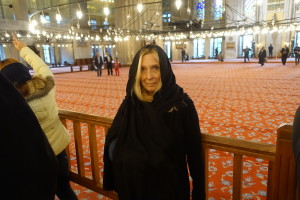
Heads must be covered for women prior to entering into the Blue Mosque. We watched the few believers inside the barricade who came to worship in this place.
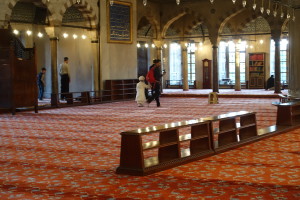
Two sets of fathers and sons–one to the left with an older son stood facing a blank wall. The other led his much younger son (dressed in white robe and turban) around the mosque taking photos in each location.
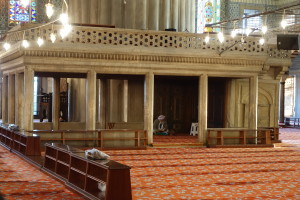
An white bearded elder sits inside the building inside the mosque, looks around and ponders a prayer book he is looking through.
Though the interior is striking with its blue tiles, high ceilings, and large worship area we’d seen enough. Time to leave.
Just as we exited the mosque the same helpful citizen walked away from his group of friends to talk with us. He asked if we took photos and said “Oh, you missed the best spot.” He led us back to the same area we’d been earlier all the while providing information about the sultans and the reason for chains hung across doorways.
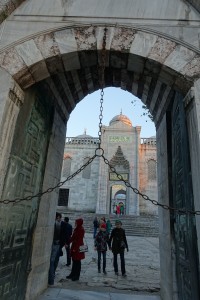
Chains across the entrance to the Blue Mosque requiring everyone (even the Sultan) to bow (to clear the chain) before entering.
We stood for a moment in the adjoining courtyard as he spoke of the mosque’s construction. Pointing to two different obelisks we learned about the Roman coliseum surrounding these and the smoke that arose from each announcing an event about to take place.
I busily took photos of the stone carvings on one obelisk and missed the following conversation. He talked of Christians slaughtered by lions in this coliseum, and boasted about the use of the bloodied stones disassembled from the coliseum to build the blue mosque. He smiled as if we were all friends. Wanting to show us his uncle’s rug shop about a block away, perhaps we’d want to purchase one to take home. Pointing to one area where this shop was located, he led us into that direction. It wasn’t there. A little further, “just around the corner”; still no rug store. We were Americans in a land surrounded by ISIS fighters. The uncle’s store was not where we understood it to be. Nothing added up.
Brian was in protection mode. This man was from Kurdishstan–a Kurd–yet, he was uninterested in other Kurds fighting for their lives just a few hundred miles away.
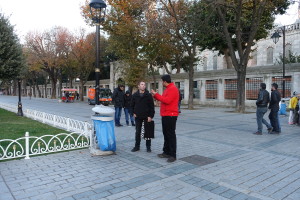
As I busily take photos of the former Roman Coliseum Obelisks, Brian stands guard protecting me from becoming another American target.
This is still the Ottoman empire. If they can’t kill you, they want to take advantage of you in some manner. Even seemingly nice people want something. With my right arm still covered in a cast with a sling protecting it, I already felt vulnerable. I don’t like to see myself as a 60 year old injured woman, but I was just that. This situation could have ended disastrously. Though we didn’t realize it at the time, Syrian refugees and injured ISIS fighters filled all the Istanbul hospitals awaiting medical treatment. Fortunately my accident happened in London, not Istanbul.
Brian kept watch. This is second nature for him. Most of the time I wasn’t aware he was watching everything around us to keep us safe–a different perspective and insight. God’s meets our needs before we realize it. Darkness was falling, it was time to return to the hotel. Night is not our friend in this city…Not now.
